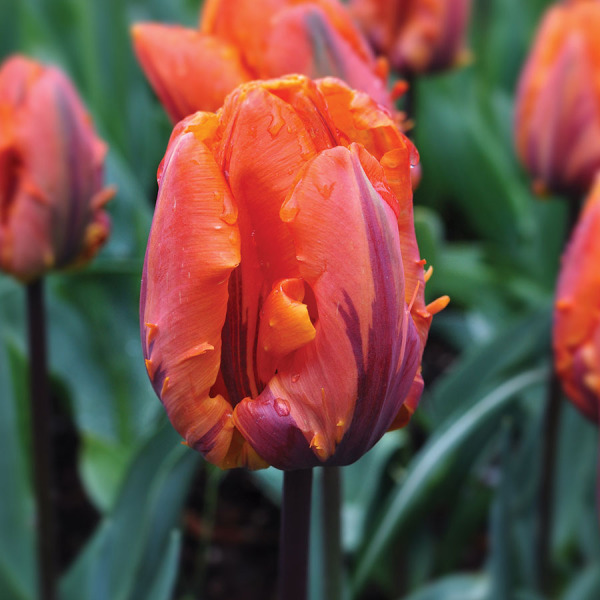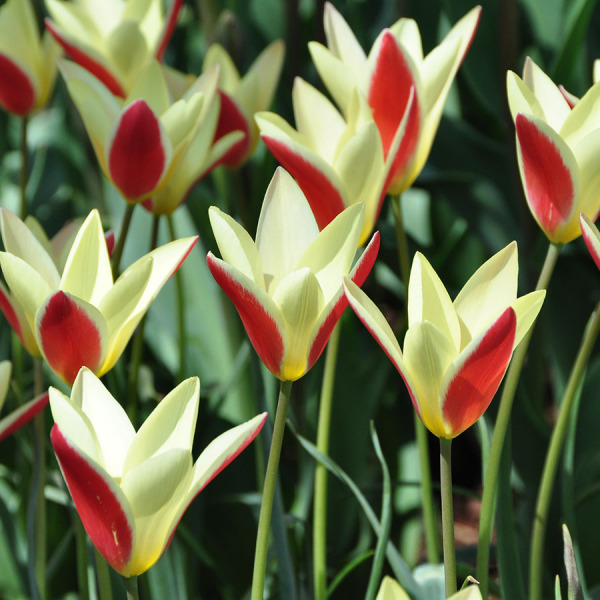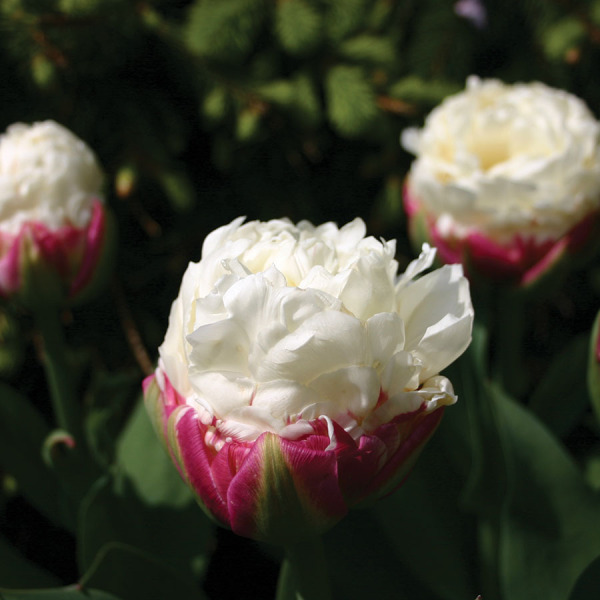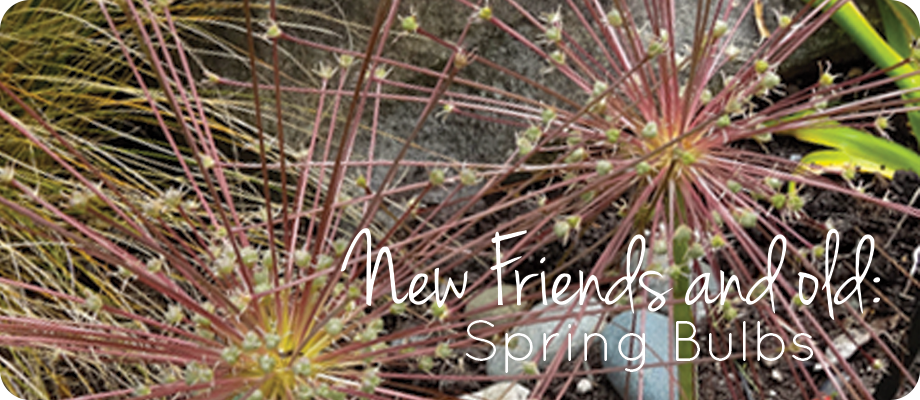
by Susan | Nov 1, 2014 | gardening, Plantswoman Design
Knowing what you like is a good thing. Trying something new is a good thing. Heading into the fall and thinking about spring bulbs I have to think about both things. One of my most favorite bulbs is Allium Shubertii.

Growing at the top of the path to the bottom garden in my old garden it never failed to amaze. In the late spring the leaves would show up and then the blooms fast behind. As the season ramps up the blooms loose their purple and become a wonderful honey color. I always pick them and bring them indoors. The uses indoors are unlimited. I use them as sculpture, spray them with white paint and glitter, (watch for them in gather post coming up), and stack them in old wooden troughs with other drying foliage. A must have for my new garden. Beware where you plant them. A customer in the city complained that passerby’s stole the bloom and even the bulbs from the planting by the sidewalk. Addictive is a word to describe this bulb!
Another must have is a species tulip batalini. There are two cultivars available one is bright gem and the other is bronze charm.

image from Pacific Bulb Society

image from tulipbulbs.com
This sweet little tulip is perfect for the edge of a path. I like it up on an edge of a rock wall that you walk past. I planted 6 several years ago and they multiplied to about 25. They like quick drainage, are drought tolerant and surprisingly deer resistant. For some reason this usual deer candy (tulips) is not a favorite. I love not worrying about them at all. Slugs don’t care about them and as you are walking by them they seem to pop up out of nowhere to cheer and surprise you.
This year on my new list is a couple of items from the tulip blog this past spring. www.Tulips.com is the website for the Skagit Valley tulip festival bulb producer, Roozengaarde, that sells the bulbs you see in the fields. My tries this year will be a parrot tulip called Irene, orange with reddish purple flames.
Another Species Tulip called clusiana Carmine, red with white edge (looks like the same cultivation as the Batalini tulip). They should be really great.
Clusiana at www.tulips.com
Sometimes there are special cultivars that are developed and tested one of which is the Ice Cream Tulip. I’m not sure that it will be a hit or not. It is dark pink on the outside of the tulip and has a raised section in the middle that looks like ice cream in a dish. Check it out and tell me what you think.
Ice Cream Tulip at www.tulips.com
At the Northwest Flower and Garden Show Last year one of the other gardens had a beautiful white tulip that was forced from the gardens in the Skagit Valley. Tulip ‘The Edge’ was amazing. It has great foliage with a small white edge of color on the leaves and pure white bloom.
The Edge at www.tulips.com
I ordered them last week and they were delivered today with instructions to plant immediately. I waited to order because it has been warm here. Sometimes if you put spring bulbs in the ground too soon they will start to sprout. We get some good cold weather but this year it hasn’t been cold yet. Gardeners in warmer climates will have to chill in a refrigerator and plant about 12 weeks before you want them to bloom. Good instructions for planting in warm climates is available on the website.
Valley Nursery had a new tulip on the shelves when I went to get bamboo for a customer. (always a danger). Tulip ‘Clouds of Cotton’ looks to be really beautiful. They have a new home in one of my new planting beds. I’ll be looking forward to seeing the blooms and reporting on how they do.

image from www.pikenursery.com
Here is a note to other on-line shoppers. I have ordered from other on-line bulb places in the past. I have not had good luck from the so-called discount bulb sellers. Last year the bulbs I ordered for the garden show had a less than 50% germination rate. Other garden creators had ordered from a local source and they had great success. I would have to say BUY LOCAL!
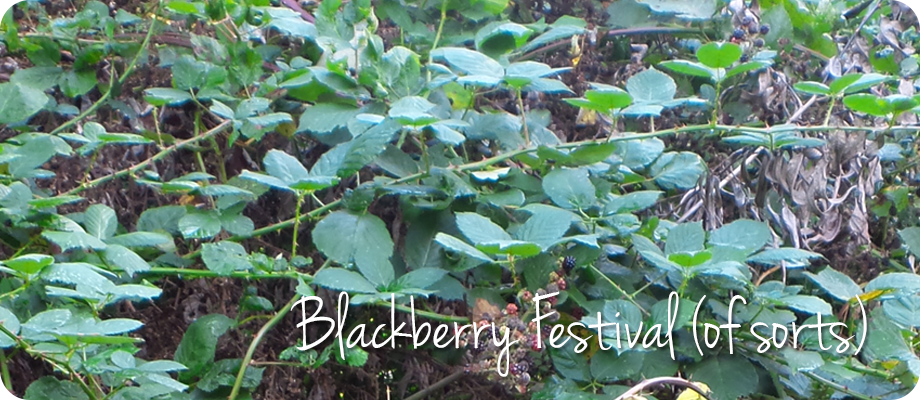
by Susan | Oct 15, 2014 | gardening, Plantswoman Design
Really, there is a blackberry festival in Bremerton, Washington. They celebrate blackberries. Fun runs, children’s events, and food and wine made with blackberries. I kind of get it but the Himalayan blackberry is a terribly invasive weed. Much like kudzu in the south, blackberries are attempting to cover the world. They spread by seed, root where they touch the ground and send underground runners. Himalayan blackberry was brought to the PNW by Luther Burbank in 1885. This plant was lauded and sold in nurseries. The plant spread outside the garden and has been a problem ever since. The city of Seattle alone is attempting to eradicate the blackberry from 2500 acres of parkland. They estimate that 20 percent of parkland are covered by the invasive weed and estimate that it will cost $ 25,000.00 per acre to remove it.
Keeping with the spirit of things I had my own blackberry festival this weekend. About 30% of my property is covered with this weed and I have battled them since I moved in. Cutting them down with a bladed weed trimmer, spraying the regrowth with brush killer then finally digging out the node that is just below the ground. Here is a picture of the stems of a plant that I cut down. The vines were climbing up a tree and were well over 30 feet high. Now that’s a weed! What is even more disturbing is that after an area was cleared of blackberry I found Bindweed and yellow archangel growing in the cleared off soil. Both of these are on the noxious weed list too!
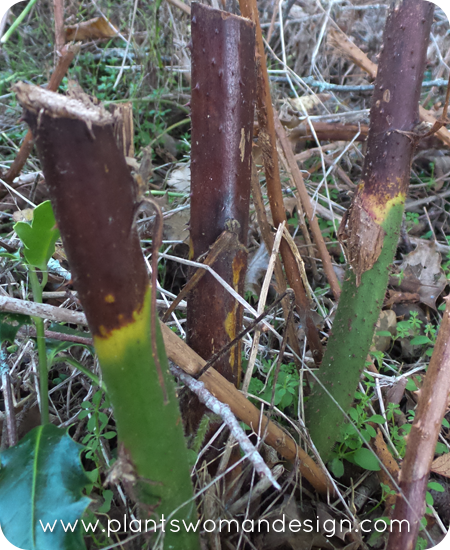
All three of these noxious weeds are considered class C noxious weeds by the Washington State Noxious Weed Board. This means individual counties can determine the control measures within the county. Class A noxious weeds are controlled by law. When you get around to it the topic of noxious weeds is very interesting reading. Many gardens in Washington have several of these weeds in their garden beds. Several years ago I found Milk Thistle on a garden center bench for sale and wanted to pitch it. It is good to be aware of what is out there, what you might have in your garden, and what you can do to control weeds in your area. The website has good suggestions for how to eradicate and what the weeds look like. Get out there and start weeding!
Check out this link http://www.nwcb.wa.gov
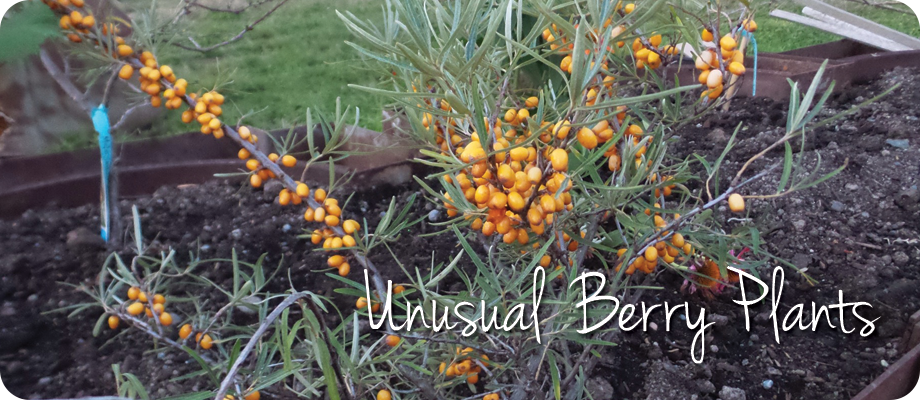
by Susan | Sep 24, 2014 | Plantswoman Design
While searching the nursery for Rhubarb I came across some interesting plants. While not finding the rhubarb I didn’t come away empty handed. My little finds didn’t look that great in their 1 gallon containers but I have faith that it will be an interesting experiment. It is amazing how many little experiments I try.
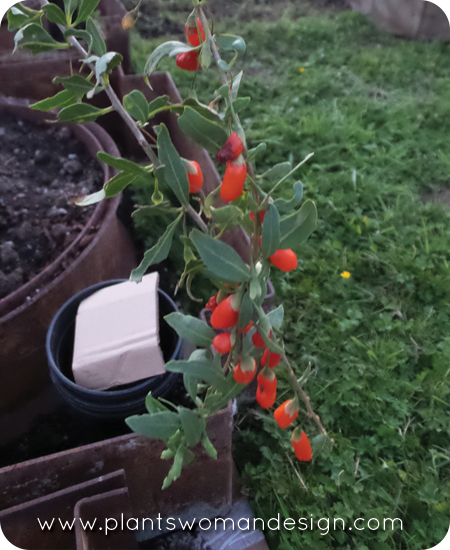
Crimson Star Gogi Berry
My first little find is the Crimson star TM Gogi Berry. It had fabulously interesting fruit hanging from long wand like branches. I even took a taste of the hanging orange berry. Not only is it good for you it tastes good which I usually see as a dried fruit and in juices.
The next little guy I found is a Lycium barbarum variety of Gogi Berry Plants and Garden Harvest Supply had some good advice…
“The Lycium barbarum variety of Gogi Berry are a perennial in zones 3 to 10, they are actually quite remarkably heat and cold tolerant. Goji plants are deciduous, which just means that they drop their leaves every year, usually once the first frost hits. Goji Berry plants are very adaptable, but for the very best results, test your soil, and then adjust the pH to between 6.8 – 8.1. You can add lime to raise the pH if necessary or aluminum sulfate to lower it.
To help your prepare this amazingly healthy superfood, we have discovered a cookbook, written by Dr. Donald R. Daugs, Goji and Wolfberry, Superfood Cook Book for Health, Flavor and Fun, filled with illustrations and 93 recipes for everything from breakfast to main dishes and including a chapter on appetizers!” (
Source)
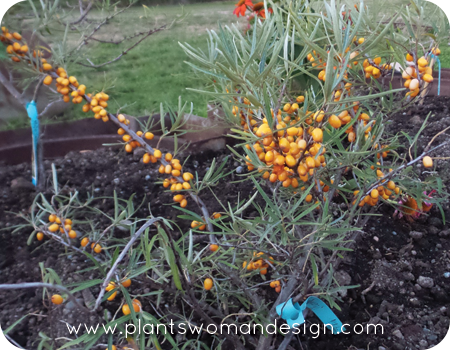
Female Sea Berry, you can see the male Sea Berry in the back to the left.
I also picked up a male and female Sea Berry, of course the berry is orange too. Here is some great info from MySeeds, “The Hippophae rhamnoides has plenty fans to recommend it as the Sea Berry is widely used for healing in Asia and Europe, where it is valued as a potent anti-oxidant, a source for Vitamin C and a healing oil. The attractive small tree or shrub, also called Sea Buckthorn, is likely the most widely grown, northern hardy, fruiting plant in the world, but most Americans have never heard of it! In Europe, the sour, flavorful fruit is sweetened and its orange-passion-fruit-like flavor makes fine sauces, jellies and a base for liqueurs. The plants, native to the Russian Far East, are incredibly productive and a great choice for backyard fruit production! Narrow silver leaves and plentiful round, yellow-orange fruit cover the 6-10′ tall, narrow, upright female forms. Give plants full sun and good drainage, and space them about 7′ apart or 3-5′ for a hedge. They are extremely hardy, to -50° F., disease resistant and easy to grow. Branches are used in floral displays, and commercial crops are harvested by cutting off entire fruit-laden branches. USDA Zones 3-9.” If you miss it in the nursery you can get it at Raintree Nursery on line. (source)
Less unusual but still a breakthrough that fruit growers in small gardens are excited about is the Raspberry Shortcake bush type raspberry. These are not running out of control canes everywhere type of raspberries. I got good production in my Miller Bay garden. This revolutionary, thornless raspberry is a little dwarf of a raspberry with an endearing compact growth habit that thrives in patio pots or in your landscape. It needs full sun, fairly neutral soil, moderate watering and good drainage. Fertilize in early spring with a balanced liquid fertilizer. It needs some chill factor. If leaves begin to yellow or droop in summer – apply a balanced liquid fertilizer and water well. It does have a compact habit and if planted in the landscape it will still produce new canes around the base of the plant. If you want it to stay in a container it is happy to oblige! (source)
I dropped one into the same garden bed as the Goji and Seaberrys. Of course the designer in me can’t resist adding a few accent plants while I’m at it. These Echinacea ‘someadobe’ have a fabulous color of orange with little bits of hot pink at the edges of the petals. Yummy color!
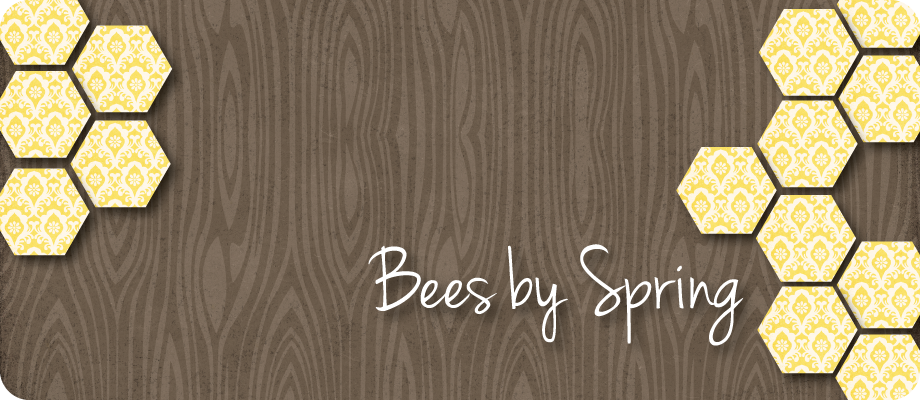
by Kristen | Sep 17, 2014 | Plantswoman Design
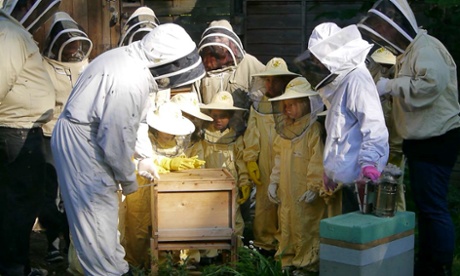
Urban Bees in the UK
As summer is winding down we are already looking ahead to early next spring and making plans… for bees!!! Mason bees to be exact. You may be ‘so over’ having bees as unwanted guests pestering you through out your outdoor endeavors. We were inundated at an outdoor morning picnic recently to the point we had to start moving the food inside. “Be careful of the wasps”, “don’t make them mad” and the ever popular “they are more afraid of you than you are of them” comments were aplenty through out the affair. But there is some confusion about bees and, before we went on a bee adventure ourselves, we wanted to find out what the deal was. So here we go…
Are all bees wasps?
No, but the term “wasp” incorporates a number of different, predatory groups such as hornets and yellow jackets.
Are bees and wasps really more afraid of me than I am of them?
Not likely, their main objective is to gather food for and protect their hive. If you are in their way they will defend what is theirs. Wasps may be more aggressive than other bees but the goal is still the same. If they were afraid of you they would likely want to be far away from you rather than continuing to pursue you and your food.
What’s the main difference between bees and wasps?
Bees, that collect nectar and are major player amongst pollinators, typically have fuzzy bodies that readily hold onto the pollen the bee comes into contact with. Wasps on the other hand don’t have a great deal of fuzz on their bodies and therefore aren’t great pollinators. Wasps, instead, prey on other insects for their food. So, if you think spraying insecticides on your garden to get rid of wasps is a good idea think twice. Besides being illegal, you are likely harming innocent pollinators rather than the often more aggressive perpetrator, wasps.
Bee keeping is growing in popularity especially amongst urban homesteaders and urban community gardens. There are many valuable resources out there to get you started if you are interested. The Plantswoman will be getting her bees in the spring and we will be sure to share our progress here on the blog. In the meantime, have patience with these flying friends. They are needed.
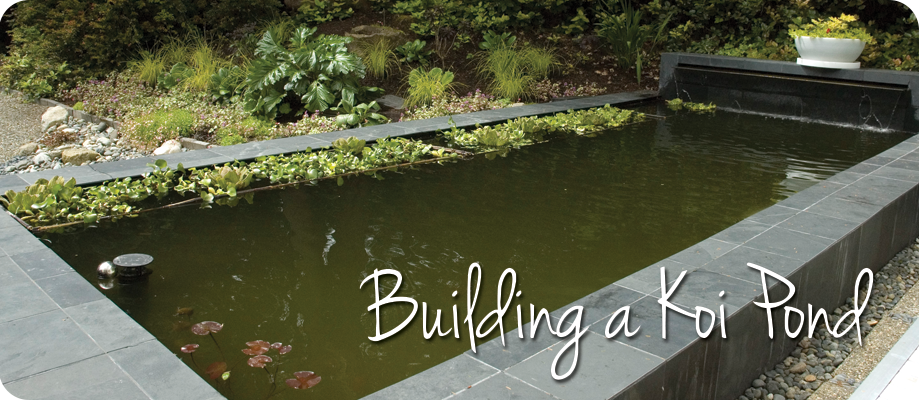
by Susan | Sep 13, 2014 | Plantswoman Design, pond
Often times customers will ask us to do something we have never done before. Of course I always say “YES!” Then my crew and I will do a little pow-wow and figure out how to do it. Occasionally we will tell our customer ‘this is new to us but we will do it for cost and you get to be our experimental model’. They are excited to see how we do it and we are excited to do something new. Most of the time we do a ‘mock up’ or try it for display. We want to be sure that something works before we put it into a landscape. We are always learning and experimenting to perfect our craft.
For today’s case we are building a koi pond. My babies moved with me and they needed a new home. They have spent the last month in a 300 gallon stock tank.
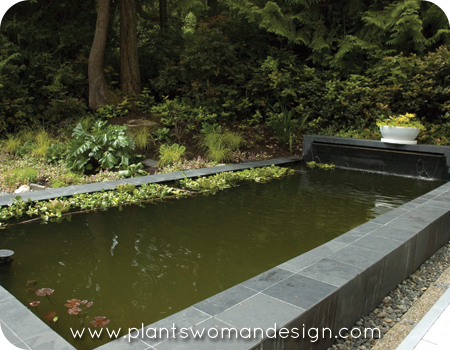 We have a customer that we helped with a koi pond for a couple of years ago. She had concrete planters in the back garden. We blocked one off and left it as a planting bed. The other bigger portion we dug out, plumbed and created a pond with a waterfall. In her project we used a spray on poly urea liner. The fabric was laid and the liner was sprayed against the wall and over the fabric. The wall was capped with black slate and it looks beautiful.
We have a customer that we helped with a koi pond for a couple of years ago. She had concrete planters in the back garden. We blocked one off and left it as a planting bed. The other bigger portion we dug out, plumbed and created a pond with a waterfall. In her project we used a spray on poly urea liner. The fabric was laid and the liner was sprayed against the wall and over the fabric. The wall was capped with black slate and it looks beautiful.
Here is the Slate Pond on Bainbridge Island before. It was concrete block and dirt.

 Here is the finished koi pond…
Here is the finished koi pond…
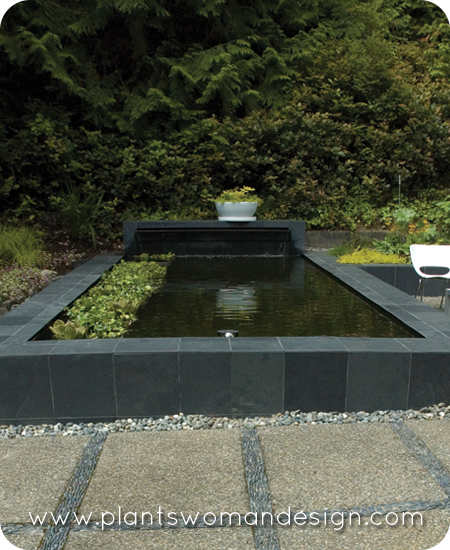
 To start the koi pond at the beach house we brought in the big diggers to start and then finished off by hand.
To start the koi pond at the beach house we brought in the big diggers to start and then finished off by hand.

 For my koi pond we are using a rubber liner. The company that does the spray on was too busy spraying ponds for shrimp farming (who knew?). The challenge here is to get the liner to stick to the concrete block we used. We need to get the liner to attach to the concrete block and then we will put the stone on the top. We tried liquid nail (a construction glue) but it did not work. I went to a fabulous store called Atlas Supply where they have all types of adhesive! They are experts so they asked about what I was doing and gave me just the right product. I used a structural adhesive called M-1 and that did the trick. The liner is laid down and stuck to the top of the wall. Now time to fill the pond and move the fish.
For my koi pond we are using a rubber liner. The company that does the spray on was too busy spraying ponds for shrimp farming (who knew?). The challenge here is to get the liner to stick to the concrete block we used. We need to get the liner to attach to the concrete block and then we will put the stone on the top. We tried liquid nail (a construction glue) but it did not work. I went to a fabulous store called Atlas Supply where they have all types of adhesive! They are experts so they asked about what I was doing and gave me just the right product. I used a structural adhesive called M-1 and that did the trick. The liner is laid down and stuck to the top of the wall. Now time to fill the pond and move the fish.
When koi move they get a little freaked out and think that everything is out to get them. They jump and sometimes make it right out of the pond. I lost one that way because he jumped at night and I didn’t find him until the morning which was too late. Another one jumped during the day and I found him outside still breathing. He had been out a long time but I dumped him back in the tank and he survived and is happy. When I moved them to the bigger pond I put a piece of netting over the top to keep them in and predators out. That was in place for a couple of weeks and then I changed it to a wire cross wire system. I want to keep eagles and osprey’s from diving into the pond to fish for their supper. Unfortunately it did not keep this curious heron from investigating.
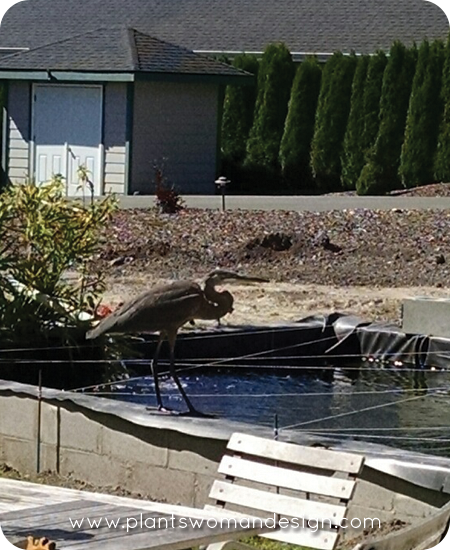 This weekend I will set up a wire around the perimeter to keep them from landing on the edge of the pond. I’m still working on the top and edges of the pond and will keep you posted on the continuing saga.
This weekend I will set up a wire around the perimeter to keep them from landing on the edge of the pond. I’m still working on the top and edges of the pond and will keep you posted on the continuing saga.
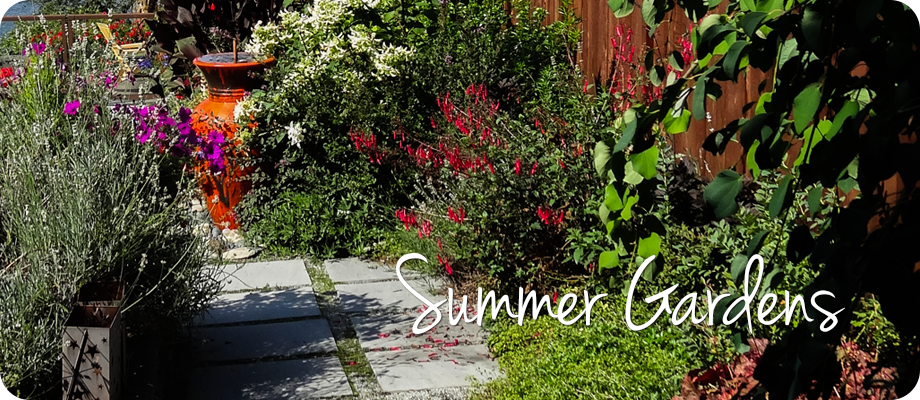
by Susan | Sep 3, 2014 | Plantswoman Design
There is something amazing about summer gardens. The effort of plants to blossom and flower is magnified as the weather warms. Descriptive words like lush, blowsy, rich, saturated and intense give way to chaotic, over the top, mish-mash, and jungle. The weather this year has kept the descriptive words coming. Little rain with great sun has produced many flowers showing off plant combinations at their best. I want to share with you a few of the gardens I’ve had the pleasure of visiting this summer. There are several that make you stop, take a breath, and just enjoy the view.

pennisetum orientalis and tsuga mertensiana

coreopsis
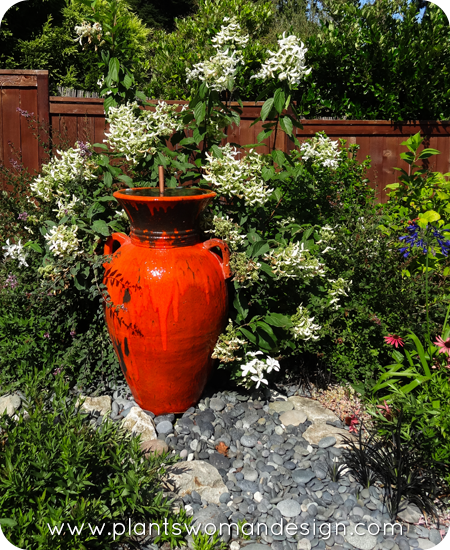
orange pot fountain

hot cannas
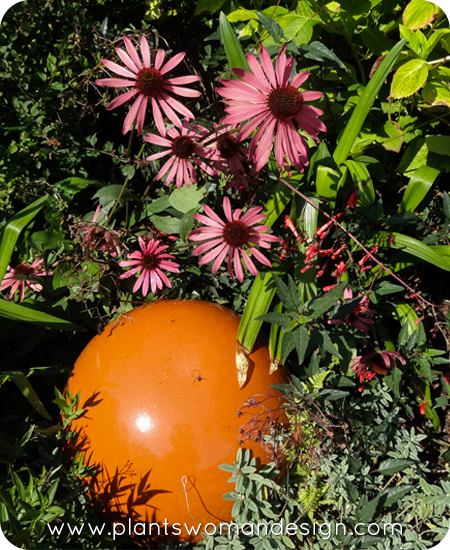
spicy orange and purple echinacea
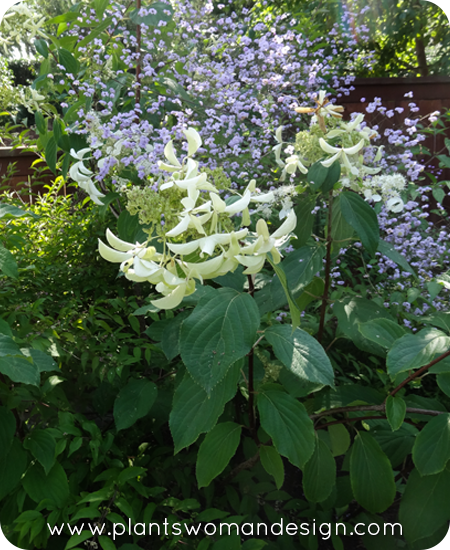
hydrangea and thalictrum
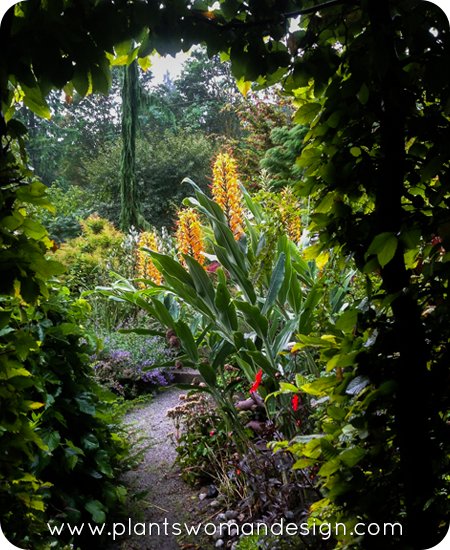

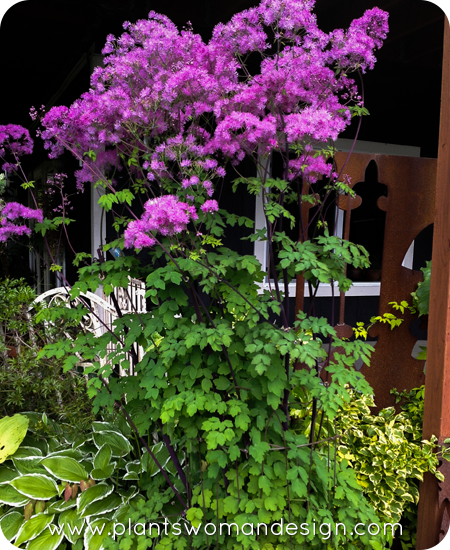



We would love to hear what says summer to you, your favorite plant combination, or favorite home grown summer food. Enjoy the last days!
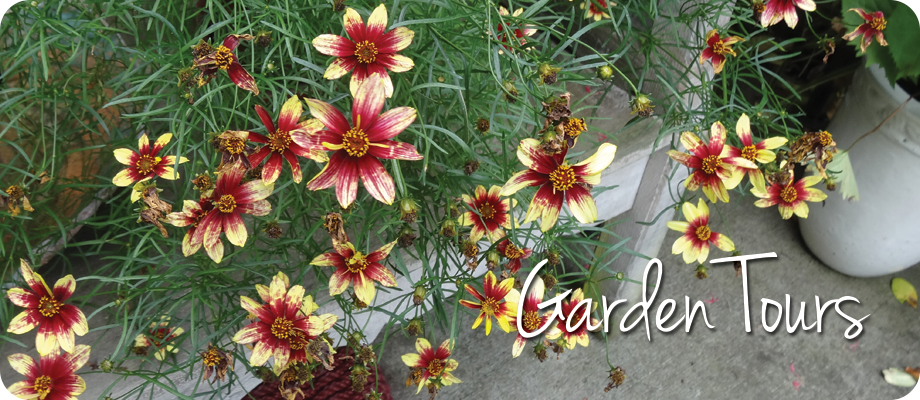
by Susan | Aug 27, 2014 | Plantswoman Design
One of the best things a gardener could do to expand their knowledge and see new things are attending garden tours. We have many in our area such as Bainbridge in Bloom Garden Tour. The Bloom attracts several hundred people each year and benefits the Arts and Humanities foundation on Bainbridge Island. The gardens featured on the tour are typically from people who love to garden and have created gardens that are noteworthy. Many times they have been ‘done’ by designers (I’ve been involved in several from the ground up). Sometimes the owner is the catalyst and is involved in every aspect of the garden. This year I connected with a lovely gardener to help with a couple of areas in her garden. I first visited her in April when things were fabulous but really specific to a spring garden. She was concerned that things still be lush and in color when the tour came in July. I helped with a few plants and support for vines, another client of mine helped with the containers, and she and her husband did the rest. Here are a few of her containers…

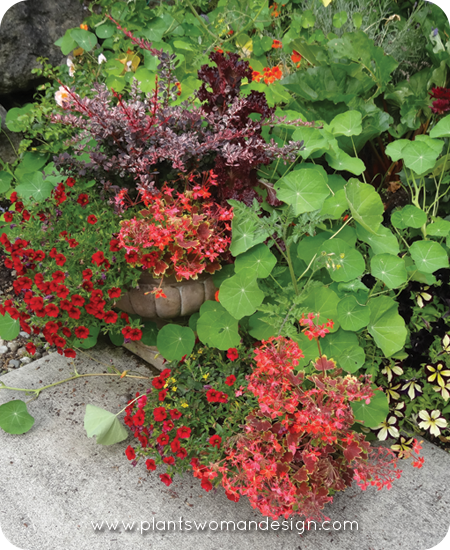 The garden is a small space around a large house in community with 4 other houses. I originally helped the builder with all the hedging, planning the outside planting beds and structures. I coordinated with the artists that created the fencing and artwork that is on each house, individual but repeated in style. This particular gardener is one of the original owners and created a beautiful garden.
The garden is a small space around a large house in community with 4 other houses. I originally helped the builder with all the hedging, planning the outside planting beds and structures. I coordinated with the artists that created the fencing and artwork that is on each house, individual but repeated in style. This particular gardener is one of the original owners and created a beautiful garden.
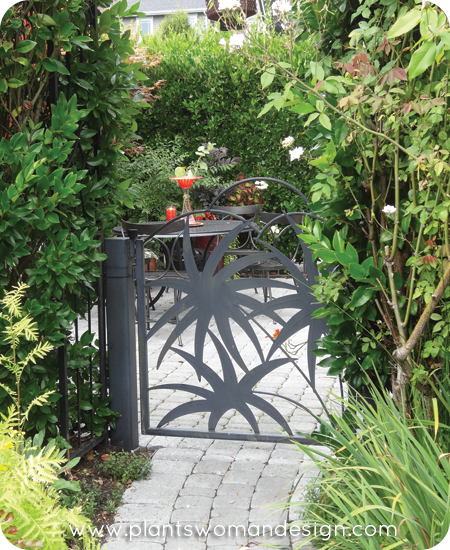
Michele Van Slyke Gate
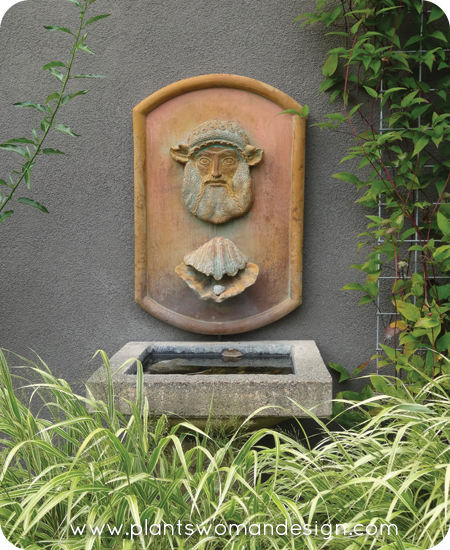
There are many different styles on a garden tour, her garden is a flower garden. One of the other houses in this community was also on the tour. That garden has the same spaces but treated in a evergreen/textured style. Contrast in leaf colors giving most of the interest instead of flowers. I was excited to see these two small gardens because many people have a small space to garden in and this helps showcase what can be done with small spaces.

Back pathway
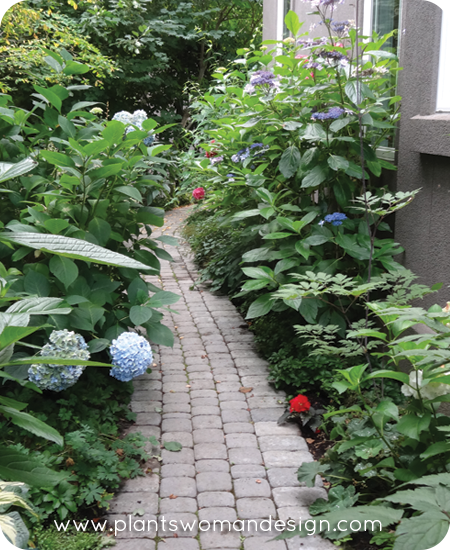
Side path
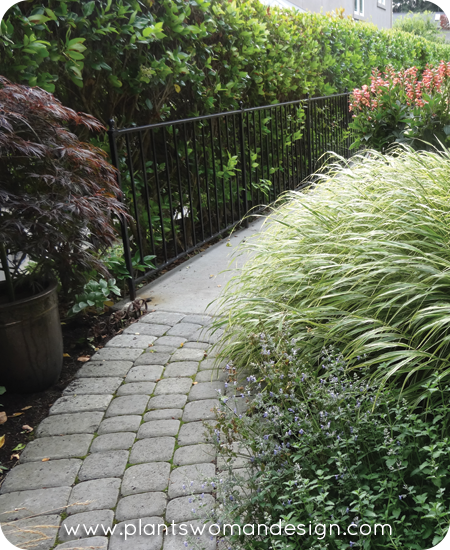
front path
I love pathways. A path tells a story. It shows progression, movement and a sense of purpose. The hedging and fencing keep the space limited on one side and the lush plantings soften the space. Closer inspection (because of the close quarters ) gives a real visual treat.
 This patio is the side entry to the house. A great space that is private and welcoming at the same time.
This patio is the side entry to the house. A great space that is private and welcoming at the same time.

Side courtyard patio.

Patio sitting surrounded by summer.
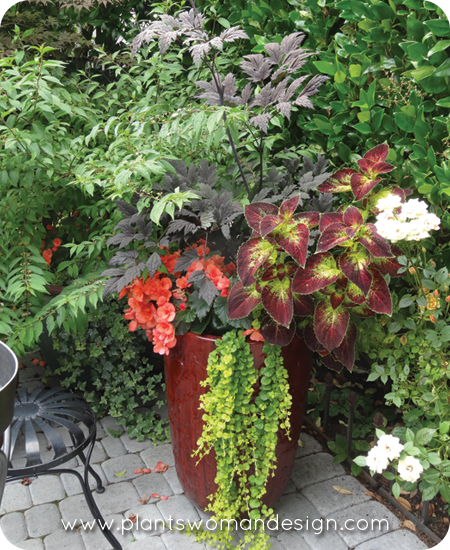 The containers by Sue Lukin are a fabulous addition to this sweet space. Concrete pavers are original to the space and are easy to maintain.
The containers by Sue Lukin are a fabulous addition to this sweet space. Concrete pavers are original to the space and are easy to maintain.
When I asked the owner what she liked most about the garden tour she said it helped her appreciate her garden more. While a labor of love on her part she thought that when the same people came back several times to look at at the plantings and wander in her garden she felt satisfied that they understood it and her through it. It felt like sharing a passion and that was unexpected.
Garden tours are like that. Go with an open mind and enjoy all the bits and pieces of each garden. Some things you will love and some things you can forget but the experience and the connection with another gardener is really the joy.
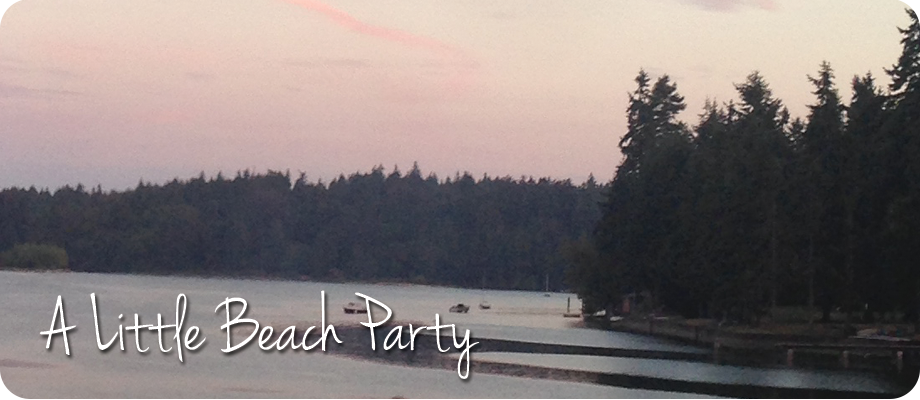
by Kristen | Aug 20, 2014 | Plantswoman Design

The family is in town and we are fully breaking in the new place. On Saturday we hosted almost 30 friends and family for a little beach party and the new house rose to the challenge. It was a pleasing sight to see folks relaxing under the cedar tree, kids down at the beach and friends milling about the drink table. We ended the night with the first of many bonfires our beach front will see. We are so happy to be together in this place.
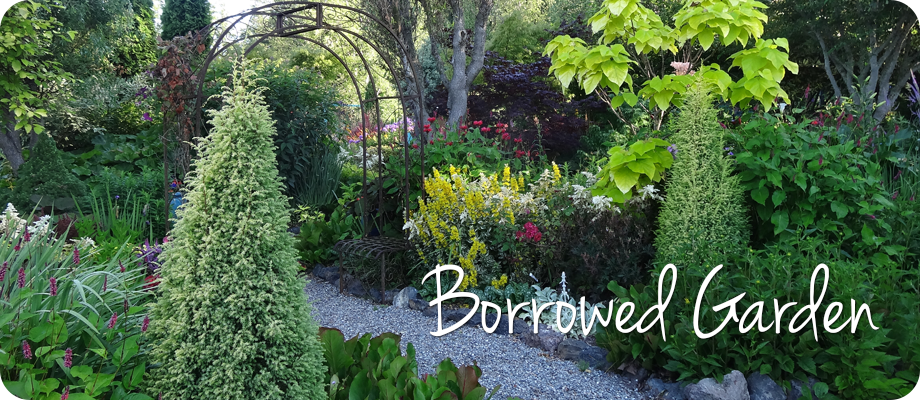
by Susan | Jul 16, 2014 | gardening, Plantswoman Design
Working in my once neglected garden I feel a little like a garden archeologist. Yes there really is such a thing. The garden I have now was once someone’s favorite project. The man who used to live here 15 years ago spent time creating this garden. He dug 3 ponds, had an elevated water aqueduct that spilled into a concrete waterwheel. An arching bridge past by it so the observer could enjoy the water wheel. It had two docks with a fountain in one of the ponds. I heard from my neighbor Jeanne that the gardener had died just 3 weeks after she moved in. In the following years the garden was left on its own. The ponds filled with algae, the stream beads were choked with weeds and alders, the aqueduct collapsed and wheel stopped turning. By then, Jeannie was engaged in her own project of remodel and garden. In the years to follow the garden she created grew and flourished, while the garden next door fell back into uncultivated earth again.
Have you ever wanted to borrow a garden? Kinda like borrowing a fancy dress for a party. You love it even though it’s not really yours but want to have the look for an evening. As I look over the acres of grass that is my ‘garden’ that is how I feel about Jeannie’s garden.
Jeannie’s garden is amazing. She has created a traditional cottage style garden with good bones. The garden by the house is lovely with aspen, hydrangeas and fruits with a small dock over the water. When they bought the small lot across the drive she created another stunning garden. Structure and texture are evident in all the beds with evergreen shrubs, arbors, garden house, and trellises. Pathways are gravel and mulch with care taken to maintain the edges.
She has beautiful plant combinations and has created an amazing garden of colors and textures with quiet (and not so quiet) places to sit and rest.
I drive by this lovely place every day, I mow next to it and have been invited to stroll its paths. I enjoy seeing her unusual plants, blooming things, and passionate use of color. She’s in her garden at 6 am and again at 8pm (her husband retired recently and she told him he could sleep until 7:30 then she wanted his help in the garden). She came over the other day and said, “Let me see what you have done.” Funny I didn’t think it was much but she immediately said it already looks like a garden. Indeed it does. I am so lucky to be next to a kindred spirit. We will watch together as it grows and changes. I’m sure we will share plants, ideas and failures.
Until next time grow on.




